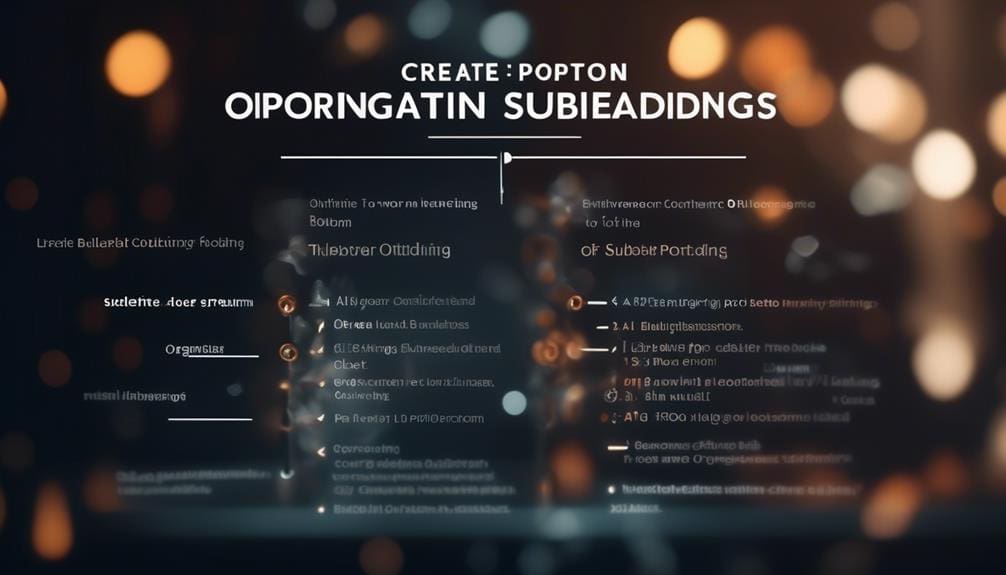The Anatomy of a Great Content Outline: Components of Success
When constructing a content outline, think of it as the skeletal framework that supports the body of your work. Each part serves a purpose, contributing to the overall strength and coherence of your message.
But what truly distinguishes a great content outline from a mediocre one? It's not just about laying out the basics; it's about infusing it with elements that captivate and resonate with your audience.
Let's explore the essential components that can elevate your content outline to new heights of success.
Key Takeaways
- Clear objectives aligned with overall strategy are crucial for successful content creation.
- Structuring key points and organizing content logically enhance readability and engagement.
- Visual elements like infographics and charts can significantly enhance content impact.
- Regular review and optimization based on data-driven insights are essential for continual improvement.
Importance of Clear Objectives

Clear objectives serve as the guiding light that illuminates the path toward successful content creation. When embarking on the journey of goal setting for your content, it's essential to define clear objectives that align with your overall strategy. These objectives act as the foundation upon which you build your content outline, ensuring that every piece of content serves a specific purpose and contributes to your overarching goals.
By aligning your objectives with the needs and interests of your target audience, you establish a strong connection that resonates with them on a deeper level. This alignment not only enhances audience engagement but also fosters a sense of trust and loyalty. Understanding your audience's preferences, pain points, and motivations allows you to tailor your content to meet their specific needs effectively.
In essence, clear objectives aren't just about setting goals for your content creation; they're about creating a roadmap that leads to meaningful audience connections and ultimately drives success in your content strategy.
Research and Data Gathering
Research and Data Gathering play a pivotal role in shaping the foundation of your content strategy, providing valuable insights to inform your content creation process. Utilizing data analysis and survey results can help you understand your audience's preferences, behaviors, and needs. By conducting thorough research, you can uncover trends, identify gaps in existing content, and discover new opportunities for engaging your target audience effectively. Here's a structured approach to guide your research and data gathering efforts:
| Research Step | Action |
|---|---|
| Define objectives | Clearly outline what you aim to achieve. |
| Conduct surveys | Gather feedback directly from your audience. |
| Analyze data | Extract key insights to drive your strategy. |
Structuring Key Points

When structuring key points, start by breaking down your main ideas into digestible chunks.
Organize these key points in a logical flow to enhance the coherence and impact of your content.
Main Ideas Breakdown
Crafting a well-structured content outline involves breaking down key points into clear and organized main ideas. To begin, start by brainstorming ideas that align with your overall content goals. Think about the message you want to convey and the main takeaways for your audience.
Once you have a pool of ideas, move on to the outlining process. This step is crucial as it helps you arrange your main ideas in a logical flow, ensuring that your content is cohesive and easy to follow. Break down each main point into subpoints if needed, providing depth and structure to your outline.
Key Points Organization
To ensure your content outline is structured effectively, the organization of key points plays a critical role in guiding your audience through a cohesive and engaging narrative. By establishing a clear organizational hierarchy, you provide a roadmap for your readers, allowing them to navigate through your content with ease.
Begin by outlining your main ideas and then structuring your key points beneath each one. This hierarchical structure not only helps in organizing your thoughts but also aids in presenting information in a logical flow. Consider the relationship between each key point and how they contribute to the overall content roadmap.
This strategic approach ensures that your audience can follow along smoothly, enhancing their understanding and engagement with your content.
Incorporating Visual Elements
Incorporating visual elements strategically enhances the overall impact and engagement of your content outline. When you infuse visual appeal and graphic design into your content outline, you create a more compelling and memorable experience for your audience. Here are three key points to consider when incorporating visual elements:
- Enhanced Comprehension:
- Visual elements such as infographics, charts, and graphs can help clarify complex information.
- Utilize icons and images to break up text-heavy sections and improve understanding.
- Increased Engagement:
- Incorporating visually appealing elements can capture the reader's attention and keep them engaged.
- Use color schemes and typography that align with your brand to create a cohesive look.
- Improved Retention:
- Research shows that people remember visual information better than text alone.
- Include images that support your key points to enhance retention and recall.
Seamless Transitions

To ensure your content flows effortlessly, focus on creating seamless transitions between sections. Make sure to provide a smooth handoff between ideas, allowing your readers to follow along without any interruptions.
Maintain a cohesive structure throughout your outline to keep your audience engaged and connected to your message.
Flow Between Sections
For a content outline to truly excel, smooth transitions between sections are essential. When transitioning between sections, consider the following:
- Transition techniques: Utilize techniques like summaries, callbacks, or foreshadowing to seamlessly connect one section to the next.
- Incorporate transitional phrases to guide the reader through the content logically.
- Use visual cues such as bullet points or numbering to indicate a shift in topics.
- Connect ideas between sections to maintain a cohesive flow throughout the outline.
Smooth Handoff Between Ideas
Creating a seamless transition between ideas requires thoughtful consideration of how each concept flows into the next, ensuring a coherent narrative for your audience. Transition techniques play a crucial role in maintaining the reader's engagement and understanding.
To achieve this, employ methods like using transitional words and phrases, repeating key ideas, or posing rhetorical questions that bridge one idea to the next. By implementing these techniques, you can guide your audience through a logical progression of thoughts, enhancing the overall coherence of your content.
Idea coherence is essential for maintaining the reader's interest and comprehension. Smooth handoffs between ideas not only keep your audience captivated but also showcase your ability to craft a well-structured and compelling narrative.
Cohesive Structure Throughout
Crafting a narrative with a seamless connection between ideas requires a careful balance of logical progression, transitional phrases, and parallel structure. Each point should naturally lead to the next, creating a coherent storyline that engages the reader. Transitional phrases such as 'In addition,' 'Moreover,' or 'However' can be used to smoothly transition between ideas, guiding the reader through the narrative. Maintaining a parallel structure throughout the outline ensures a unified and organized presentation, enhancing the clarity and coherence of the content. By incorporating these elements, a well-crafted narrative can captivate the audience and effectively convey the intended message.
Creating a narrative that flows smoothly and maintains structural clarity is essential for engaging the reader and effectively conveying the intended message. Logical progression, transitional phrases, and parallel structure all play a crucial role in ensuring that the content is well-structured and easy to follow. By carefully organizing ideas and using appropriate transitions, the narrative can unfold in a way that captivates the audience and keeps them engaged from start to finish. With a cohesive structure and a clear storyline, the narrative becomes more compelling and impactful, leaving a lasting impression on the reader.
Utilizing Subheadings Effectively

Strategically incorporating subheadings into your content not only enhances readability but also facilitates effective organization for your readers. By utilizing a clear subheading hierarchy, you guide your audience through your content, helping them grasp the main points and supporting details efficiently. To enhance engagement, consider using visual aids within your subheadings to provide a visual break and captivate your readers' attention. Additionally, incorporating transitions within your subheadings can create a seamless flow between sections, ensuring that your audience stays connected to the narrative of your content.
| Subheading Hierarchy | Engagement |
|---|---|
| Clear levels of subheadings help in organizing content effectively | Visual aids can enhance engagement by breaking the monotony |
| Consistent formatting of subheadings creates a structured reading experience | Including interactive elements within subheadings can boost reader interaction |
| Using descriptive subheadings gives readers a preview of what's to come | Transitions within subheadings maintain a smooth transition between ideas |
When done thoughtfully, subheadings can transform your content outline into a dynamic and engaging piece that resonates with your audience.
Audience Engagement Strategies
To enhance audience engagement effectively, consider implementing tailored strategies that resonate with your target readers. Engaging your audience is key to building a loyal following and increasing the reach of your content.
Here are some innovative strategies to boost audience engagement:
- Interactive Polls: Utilize interactive polls within your content to gather feedback and opinions from your readers. This not only encourages active participation but also provides valuable insights into the preferences of your audience.
- Ask thought-provoking questions that prompt responses and discussions.
- Incorporate visuals and interactive elements to make the polls more engaging and visually appealing.
- Share the results of the polls with your audience to maintain transparency and foster a sense of community.
Call to Action Integration

Integrating a compelling call to action into your content not only guides readers towards desired actions but also serves as a powerful tool for driving engagement and conversions. By strategically incorporating action-oriented prompts and interaction strategies, you can enhance the effectiveness of your content. Here are some key elements to consider when integrating a call to action:
| Action-Oriented Prompts | Engagement Techniques | Conversion Tactics |
|---|---|---|
| Use clear and concise language to direct readers on the next steps. | Encourage social sharing to widen your content's reach. | Offer exclusive deals or discounts to incentivize immediate action. |
| Create a sense of urgency to prompt immediate responses. | Utilize interactive elements like polls or quizzes to keep readers engaged. | Provide multiple call-to-action buttons throughout the content for easy access. |
| Personalize the call to action based on the reader's interests or behavior. | Foster a sense of community by encouraging comments and discussions. | A/B test different call-to-action placements to optimize conversion rates. |
| Leverage storytelling to emotionally connect with the audience and drive action. | Organize contests or giveaways to boost audience participation. | Implement retargeting strategies to re-engage users who didn't initially convert. |
| Include visually appealing elements such as buttons or banners to attract attention. | Incorporate gamification elements to make the call to action more interactive. | Simplify the conversion process by reducing form fields or steps required. |
Review and Revision Process
By enhancing your content through compelling call-to-action integration, you naturally propel yourself towards a meticulous review and revision process that ensures your message resonates effectively with your audience.
To optimize your review process and content refinement, consider the following key points:
- Iterative Evaluation: Continuously assess your content at various stages to identify areas for improvement and refine your message effectively.
- Regularly gather feedback from your audience to understand their perspectives and tailor your content to meet their needs.
- Strategic Alignment: Align your content with your overall goals and objectives to ensure that each revision contributes to the desired impact.
- Evaluate how each element of your content aligns with your brand voice, message, and objectives to maintain consistency and effectiveness.
- Data-Driven Insights: Utilize data analytics and performance metrics to inform your review process and refine your content based on quantifiable results.
- Monitor key performance indicators to measure the success of your content and make data-driven decisions to enhance its effectiveness.
Frequently Asked Questions
How Can I Ensure That My Content Outline Effectively Captures the Tone and Voice of My Brand?
To capture your brand's voice effectively in your content outline, focus on tone optimization. Ensure consistency in content tone and voice throughout. This strategic approach will help convey your brand's identity clearly and innovatively.
What Are Some Best Practices for Incorporating Storytelling Elements Into a Content Outline?
When incorporating storytelling elements into your content outline, focus on character development and plot structure. Create conflict that leads to emotional connection with your audience. Resolve conflicts effectively to keep them engaged and invested in your brand.
How Can I Optimize My Content Outline for Search Engine Optimization (Seo) Purposes?
To optimize your content outline for SEO purposes, start with thorough keyword research. Strategically incorporate relevant keywords throughout to boost visibility. Organize your content outline with SEO optimization in mind to increase search engine rankings effectively.
Are There Specific Tools or Software That Can Help Streamline the Content Outlining Process?
When it comes to content outlining tools, there are various software options available that can streamline the process for you. These tools offer features like organization, collaboration, and efficiency, making content creation more efficient.
What Are Some Common Pitfalls to Avoid When Creating a Content Outline?
When creating a content outline, avoid pitfalls by ensuring clarity, relevance, and organization. Be strategic in your approach, keeping the audience in mind. Effectiveness hinges on avoiding tangents, maintaining structure, and incorporating engaging elements for impact.
Conclusion
In conclusion, a great content outline is the foundation for success in any writing project. By setting clear objectives, conducting thorough research, and structuring key points effectively, you can create engaging and impactful content.
Incorporating visual elements, utilizing subheadings, and implementing audience engagement strategies are key components to keep your readers interested. Remember to include a call to action and always review and revise your outline to ensure it meets your goals.
With these components in place, you're on your way to creating exceptional content.








